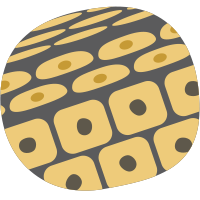
Dermal Cell News
Dermal Cell News is an online resource highlighting the latest research about wound healing, skin disorders, and dermal cancers.
Overcoming BRAF and CDK4/6 Inhibitor Resistance by Inhibiting MAP3K3-Dependent Protection Against YAP Lysosomal Degradation
[Experimental & Molecular Medicine] Researchers identified MAP3K3 as a target for overcoming anticancer drug resistance. Depletion of MAP3K3 led to a substantial reduction in the yes-associated protein (YAP) protein level in melanoma and breast cancer cells.
PARP1 Expression Predicts PARP Inhibitor Sensitivity and Correlates with Metastatic Potential and Overall Survival in Melanoma
[International Journal Of Cancer] The authors found that melanoma cells with high basal poly (ADP-ribose) polymerase (PARP1) expression exhibited significantly increased cell death after PARP inhibitor treatment, owing to higher PARP1 trapping compared with melanoma cells with low PARP1 expression.
Epidermal Retinol Dehydrogenases Cyclically Regulate Stem Cell Markers and Clock Genes and Influence Hair Composition
[Communications Biology] Scientists demonstrated that all-trans-retinoic acid (ATRA) signaling cycles during hair follicle regeneration. This pattern was disrupted by genetic deletion of epidermal retinol dehydrogenases 2 (RDHE2) and RDHE2-similar that catalyzed the rate-limiting step in ATRA biosynthesis.
Extracellular Vesicles Released by Keratinocytes Regulate Melanosome Maturation, Melanocyte Dendricity, and Pigment Transfer
[Proceedings Of The National Academy Of Sciences Of The United States Of America] The authors showed that keratinocyte extracellular vesicles enhanced the ability of melanocytes to generate dendrites and mature melanosomes and promoted their efficient transfer.
Energy Metabolism As Therapeutic Target for Aged Wound Repair by Engineered Extracellular Vesicle
[Science Advances] Researchers demonsrated that metformin engineered extracellular vesicles could enhance aged mouse skin repair, as well as ameliorate cellular senescence and restore cell dysfunctions.
Genomic Deletions Explain the Generation of Alternative BRAF Isoforms Conferring Resistance to MAPK Inhibitors in Melanoma
[Cell Reports] Using different in vitro models of alternative BRAF mRNA isoforms (altBRAF)-mediated melanoma resistance, researchers demonstrated the production of altBRAFs exclusively from the BRAF V600E allele, correlating with corresponding genomic deletions.
Combined Therapy of Dabrafenib and an Anti-HER2 Antibody–Drug Conjugate for Advanced BRAF-Mutant Melanoma
[Cellular & Molecular Biology Letters] The authors evaluated the therapeutic efficacy of RC48, alone or in combination with dabrafenib, in BRAF-mutant cutaneous melanoma cell lines and cell-derived xenograft models.
Living Artificial Skin: Photosensitizer and Cell Sandwiched Bacterial Cellulose for Chronic Wound Healing
[Advanced Materials] Inspired by the bio-functionality of natural skin, investigators bioengineered an artificial skin with bacterial cellulose sandwiched between photosensitizers and functionalized living cells. The artificial skin was non-toxic, biocompatible, and accelerated the healing process of infected diabetic wounds
Bioengineered MSCCxcr2 Transdifferentiated Keratinocyte-Like Cell-Derived Organoid Potentiates Skin Regeneration Through ERK1/2 and STAT3 Signaling in Diabetic Wound
[Cellular And Molecular Life Sciences] 3D skin organoids generated using MSCCxcr2-derived keratinocyte-like cells upon grafting in a relatively avascular and non-healing wounds of type 2 diabetic transgenic mice resulted in a significant enhancement in the rate of wound closure by increased epithelialization and endothelialization.
A Frog Skin-Derived Peptide Targeting SCD1 Exerts Radioprotective Effects Against Skin Injury by Inhibiting STING-Mediated Inflammation
[Advanced Science] 26 increased peptides were identified in skin tissues of frogs (Pelophylax nigromaculatus) exposed to electron beams, among which four promoted the wound healing of irradiated skin in rats.
ASH2L Mediates Epidermal Differentiation and Hair Follicle Morphogenesis via H3K4me3 Modification
[Journal Of Investigative Dermatology] Scientists constructed a mouse model of specific ASH2L deletion in epidermal progenitor cells and investigated its effect on the development of mouse epidermal lineage. Deletion of ASH2L in epidermal progenitor cells caused thinning of the suprabasal layer of the epidermis and delayed hair follicle morphogenesis in newborn mice.
Generation of Two iPSC Lines From Patients with Inherited Central Core Disease and Concurrent Malignant Hyperthermia Caused by Dominant Missense Variants in the RYR1...
[Stem Cell Research] Scientists generated iPSC lines from two patients with central core disease and malignant hyperthermia caused by dominant RYR1 variants within the central region of the protein. Both lines displayed typical iPSC morphology, uniform expression of pluripotency markers, trilineage differentiation potential, and had normal karyotypes.
As the largest organ in the human body, the skin is implicated in a wide range of health conditions. Dermal Cell News is dedicated to covering it all. Our website, newsletter, and Twitter feed highlight research on tissue regeneration in the treatment of skin wounds, burns, cancers, and disorders. We also feature relevant job postings and upcoming events.

 Cancer Stem Cell News
Cancer Stem Cell News Cell Therapy News
Cell Therapy News Dermal Cell News
Dermal Cell News Endothelial Cell News
Endothelial Cell News ESC & iPSC News
ESC & iPSC News Extracellular Matrix News
Extracellular Matrix News Hematopoiesis News
Hematopoiesis News Hepatic Cell News
Hepatic Cell News Human Immunology News
Human Immunology News Immune Regulation News
Immune Regulation News
 Intestinal Cell News
Intestinal Cell News Mammary Cell News
Mammary Cell News Mesenchymal Cell News
Mesenchymal Cell News Muscle Cell News
Muscle Cell News Neural Cell News
Neural Cell News Organoid News
Organoid News Pancreatic Cell News
Pancreatic Cell News Prostate Cell News
Prostate Cell News Pulmonary Cell News
Pulmonary Cell News
